#pallimnarchus
Explore tagged Tumblr posts
Text
Paludirex: Life of the Swamp King
Having gotten the long taxonomic history of Pallimnarchus and Paludirex out of the way (see here), lets talk more about the animal itself.
As far as we know at this point in time, Paludirex was the last of the large semi-aquatic mekosuchines and the largest members of this group had ever gotten. Whereas the cleaver-headed Baru dominated the waterways of the Oligocene and Miocene, Paludirex lived from the Pliocene and Pleistocene. There is some division between the species tho as it appears. Given the ambiguity around the origin of some Paludirex vincenti specimens, this species is currently only known from the Pliocene, whereas Paludirex gracilis is currently only known from the Pleistocene. There may also be a third species from the same region as Paludirex vincenti.
Comparisson between Paludirex gracilis (left) and Paludirex vincenti (right)

Anatomically, Paludirex has a pretty easily recognizable animal. Unlike Baru, with its short, triangular skull, Paludirex had a head that was almost rectangular when viewed from above, about half as wide as long and comparably flat. Mind you the skull can still be pretty deep, especially in Paludirex vincenti, but the proportions still highlight how wide it is most of all. In both robustness and skull width, Paludirex far exceeds what is known in modern saltwater crocodiles, which likely fill a similar niche.
Left: Skull reconstruction of Paludirex vincenti. Right: Life reconstruction of Paludirex (Nellie Pease)
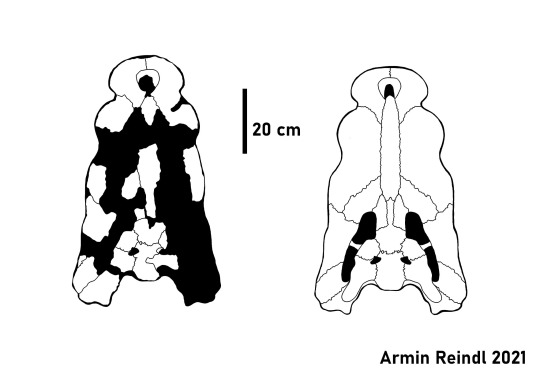

As said before, Paludirex represents the biggest mekosuchine. At a minimum length of 4 meters, it already rivals many of today's crocodiles and Baru, and that's just the smaller ones. Large individuals of Paludirex vincenti probably got much larger, 5 meters and more further drawing parallels to todays salties.
A size comparisson between Steve Irwin and both species of Paludirex

Now while the description is pretty sound on account of recent work by Ristevski and co., the ecology is a different matter. A lot of work was published back when Pallimnarchus was still a thing, so trying to separate what and what isn't applicable these days is a bit of a challenge.
On the most simple level, Paludirex was a generalist semi-aquatic ambush hunter. It's skull, tho incredibly robust and wide, shows no peculiar adaptations like long slender jaws so its obviously not a specialist. It's semi-aquatic because the nostrils and eyes face up so that they would peer out from the water while the rest of the body remained submerged. And these last two together basically suggest ambush-hunting.
Willis and Molnar also made comparissons between Paludirex skulls (or rather skulls now recognized as such) and Mugger crocodiles. All in all this suggests that its diet could have ranged from turtles to aquatic birds to large mammals (so the typical croc range really). They also infer that it may have had similar habitat preferences, being found in marshes, swamps, rivers, lakes, anywhere theres freshwater really. One exception may be that some researchers have argued that Paludirex was avoiding saltwater and brackish water, which eventually could have factored into its extinction once inland waterways in Queensland dissappeared.
Top: Eastern Sahul megafauna, the foreground features Paludirex about to ambush a giant kangaroo (Ryan Bargiel, Vlad Konstantinov, Andrey Atuchin & Scott Hocknull) Bottom left: Paludirex vincenti (Diego Ortega Anatol) Bottom right: An unforunate Paludirex being attacked by a marsupial lion (Joschua Knüppe)

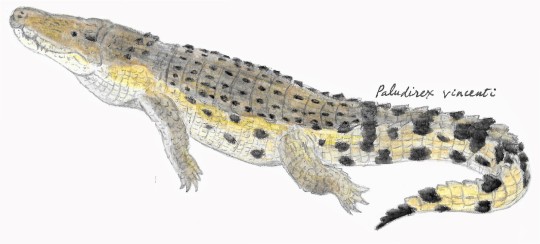

As with many crocs, its pretty likely that individuals were hostile towards each other at certain times, perhaps during territorial disputes or in the mating season. Now this one's a bit of a more ambiguous one regarding the assignment of the fossils. Fossils of leg material show clear bite marks, HOWEVER, the fossils were assigned to Pallimnarchus purely on the basis that they don't appear to have belonged to a terrestrial animal (as often inferred for Quinkana) nor to a modern croc. Based on this, the material was assumed to have been that of Pallimnarchus without much else to back it up. Now that Pallimnarchus is no more, it is reasonable to assume that it may be Paludirex but then again, it could also be an entirely different animal. Only way to tell would be to find Paludirex fossils with leg fossils attached.
This does bring up the interesting discussion, what crocs did coexist with Paludirex? Well there's a couple. As just mentioned, there's Quinkana, which I'll research more in depth later, but for now it's commonly assumed to be more terrestrial than other mekosuchines. There's the Darling Downs form, which lived around the same time as Paludirex vincenti in Queensland and may be a third species of this taxon. Gunggamarandu is another animal from this region, tho much as with Paludirex its not entirely clear if its Pliocene or Pleistocene. More certain is the fact that during the Pleiostocene, Paludirex gracilis coexisted with freshwater crocodiles in the Riversleigh WHA. Finally, there's indetermined species of crocodiles that date as far back as the Pliocene. Historically, they've been regarded as salties, but more recently it's though that they were a different species entirely and that salties only moved in recently, possibly after Paludirex went extinct and the niche of large semi-aquatic predator was free.
Top left: Quinkana faces off against Megalania (Hodari Nundu) Top right: A freshwater crocodile running (Brandon Sideleau) Bottom: Gunggamarandu, a relative of today's gharials (Eleanor Pease)


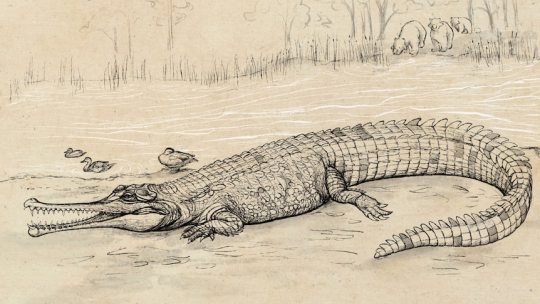
By this point I've basically already given away the reason why Paludirex is no more. With mekosuchines already taking a massive hit during the late Miocene, the group was not at its peak when Paludirex came around. And things were not getting any better as Australia grew more and more arid, river systems disappearing, freshwater drying up and the habitat of these animals shrinking bit by bit. Paludirex, presumably staying clear of coastal waters, was hit hard by these events and eventually it was just too much. And once it was out, saltwater crocodiles moved in, leading into the modern day.
#paludirex#pallimnarchus#palaeoblr#pliocene#pleistocene#australia#paleontology#prehistory#crocodile#croc#crocodilia#mekosuchinae#gunggamarandu#paludirex vincenti#paludirex gracilis#quinkana
119 notes
·
View notes
Text
Pallimnarchus and Paludirex: A History of the Swamp Kings
This is only part one of a two part series, ecology and anatomy will be discussed in part 2 because theres just too much history to cover.
Paludirex is a fascinating genus with a complex history. You see, while it was only named 3 years ago, it actually serves as a direct successor to the first fossil croc to have been described from Australia, all the way back in 1886.
Back then, a certain Charles Walter De Vis discovered a multitude of croc fossils in Queensland, specifically the Darling Downs region. Now with all due respect, while De Vis was definitely an important researcher...some of his work doesn't really hold up. In the case of these specific fossil remains, we now know that the fossils belonged to multiple specimens and at least THREE different species. De Vis also straight up admitted that he was not very familiar with Cenozoic crocodiles, which is why he didn't name it....well, sorta. De Vis did in fact not describe a new genus that much is true, however, he did give the material the name Pallimnarchus pollens. De Vis explains that he did so out of convenience and to some degree its understandable. It's always easier to refer to an animal by name than the specimen number, like the Darling Downs Taxon we'll discuss in part 2. But by making it sound like a proper scientific name, De Vis kinda set things up to get messy later.
Charles Walter De Vis (left), multiple fossils originally attributed to Pallimnarchus including those now attributed to Quinkana in B (right)

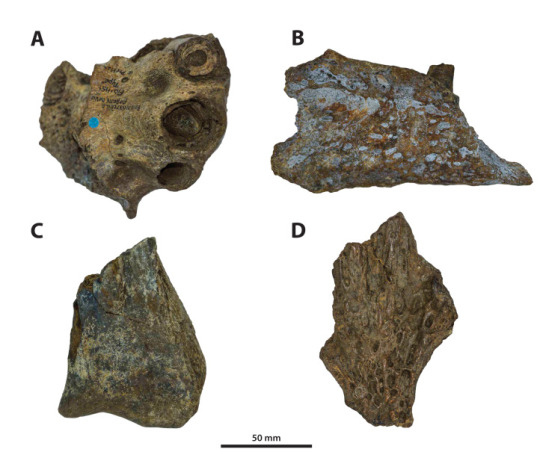
Sure De Vis only meant for Pallimnarchus to be an unofficial name, but subsequent authors didn't exactly bother ammending that fact. Instead, more and more research was published referring material of Australian crocodiles to Pallimnarchus without further question. This largely went unchecked until 1982, when famed Australian paleontologist Ralph Molnar chimed in. Molnar recognized the issues with Pallimnarchus and, in an effort to clear things up, decided to do what should have been done long ago. He picked out the best fossil of De Vis' collection, a lower jaw, designated it as the lectotype and described it in full to establish how it differed from other crocs of the region. Sadly, Molnar was a couple of years too early. In 1982, there were only four crocs to compare it to. The Saltwater Crocodile, the Freshwater Crocodile, the New Guinea Crocodile and Quinkana. What Molnar couldn't have known is that only 8 years later, the fossil record of Australian crocs would change forever with a sudden boom of research describing a plethora of new forms, the Mekosuchinae. So while Molnar's comparisson was adequate for the time, it soon turned out to just not be enough.
Ralph Molnar (left), the lectotype of Pallimnarchus with the only still known material highlighted (right)


Aside from scientists naming a metric shit ton of other crocodiles from the continent, three other important things happened during the 80s and 90s. Firstly, we finally found more good Pallimnarchus fossils. Remember, the De Vis fossils were largely a collection of random, unrelated fossils, the lectotype a partial lower jaw and the only good cranial fossil was the Lansdowne Snout, which people constantly argued over whether or not it was Pallimnarchus or simply a salty. But now we got two pretty great fossils. There is the Mirani Shire Skull, certainly the lesser of the two because someone encased the entire top half in concrete (thanks for that). And then there's the Dalby Specimen, better known as Geoff Vincent's Skull, an incredibly informative collection of skull fragments of a single individual and probably one of the best fossil of this animal.
The second major thing to happen is that in 1997, Molnar teamed up with Paul Willis, who basically had a hand in nearly every described mekosuchine, and once again reevaluated Pallimnarchus. The main takeaway of their work was that they now recognized a second species which they dubbed Pallimnarchus gracilis.
And then there's the third thing. The lectotype was lost and only a small fragment was ever found again. Things were not looking good.
A photograph of Paul Willis (left) and multiple older images of Geoff Vincent's skull (right)


More and more mekosuchines were described in the 2000s, yet things went mostly quiet around Pallimnarchus. The redescription insufficient, the lectotype lost, it had essentially landed in taxonomic limbo with no clue whether or not the name itself was actually valid.
Enter Jorgo Ristevski. Somewhat of a rising star in Australian fossil croc research, Ristevski and several other authors (including Molnar) published a paper meant to finally deal with the issue of Pallimnarchus. Their conclusion, well, sadly Pallimnarchus is a nomen dubium. It's not really a shock given that none of the previous papers ever established any actually unique traits and no such traits could be found in what little remains of the lectotype, but it was an important step none the less. So what now, this historically important genus with countless of referred specimens is no more. Well, thank fuck we got Geoff Vincent's skull.
Yes, with how well preserve that fossil is, Ristevski and colleagues managed to use it to establish a new genus that was meant to serve as a successor to Pallimnarchus, effectively meant to house the material previously assigned to the dubious genus. To honour the legacy of Pallimnarchus, they named this new genus Paludirex, both names translating to "swamp king". Of course with so much material, it was hard to evaluate everything. But there's some key finds. In addition to the Geoff Vincent's skull, both an isolated snout fragment and the Mirani Shire skull could be attributed to Paludirex vincenti, the new type species. Ristevski also confirmed the validity of Pallimnarchus gracilis (now Paludirex gracilis), tho restricting it to two fossils found in the Riversleigh WHA. Furthermore, earlier this year Ristevski was also able to confirm that the Lansdowne Snout belonged to Paludirex as well.
Jorgo Ristevski with the skull of Baru (left), skeletal reconstruction of the skull of Paludirex vincenti (right)
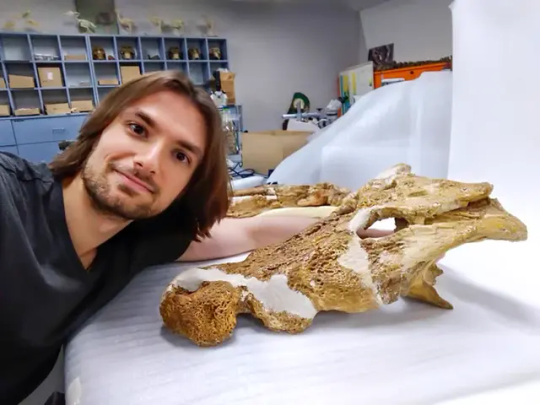

That does still leave a lot of material of course. Since Pallimnarchus was defined based on its lower jaw, and Paludirex has no lower jaw material to speak of, we can't actually confirm if any of the former Pallimnarchus mandibles are referrable to Paludirex. This lack of overlap also creates the fascinating hypothetical that, should we rediscover the lectotype and lower jaw material associated with Paludirex material, then it may be possible that the two become synonyms once more....or that we had two animals on our hands all along. But first we would need to find more material and that may still take a while.
#pallimnarchus#paludirex#palaeoblr#prehistory#cenozoic#mekosuchinae#croc#crocodile#paleontology#long post
23 notes
·
View notes